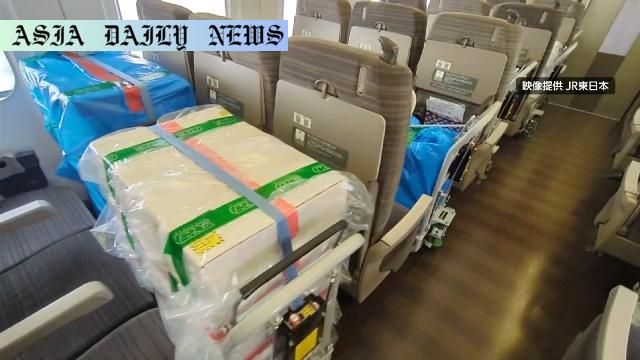Shinkansen Freight: JR East launches a weekly bullet train transport service aimed at revitalizing cargo operations.
Shinkansen Freight: Regular cargo service launches on Tohoku line.
Two cars per train allocated for transporting 200 boxes of goods.
JR East plans to expand service to Joetsu and Yamagata lines.
The initiative aims to generate annual revenue of $70 million.

Introduction: JR East’s Bold Step Towards Freight Innovation
In a groundbreaking move, East Japan Railway Company (JR East) has commenced a revolutionary freight service that incorporates Shinkansen bullet trains into regular cargo operations. This initiative, launched on the Tohoku Shinkansen line, unites speed, efficiency, and innovation to address changes in Japan’s population dynamics and diversify the company’s revenue streams. The service aims to fill a gap caused by declining passenger numbers, leveraging Japan’s iconic high-speed railway network as a means of transporting goods.
The Vision Behind Shinkansen Freight
The Shinkansen freight services use two out of ten carriages in each train, with a focus on transporting small to medium-sized cargo such as marine products, furniture, and other consumer goods. Each dedicated carriage accommodates approximately 200 cardboard boxes, making this an effective choice for businesses seeking fast and reliable delivery options. This innovative approach allows Shinkansen, traditionally reserved for passenger travel, to respond to emerging market needs by bridging passenger and freight transport.
Notably, the detailed logistics behind this service illustrate JR East’s foresight. Cargo from Shin-Aomori Station can arrive at Tokyo Station—a 700-kilometer journey—in a mere three hours. This speed significantly surpasses traditional transport methods, offering businesses a competitive edge. The service operates weekly on Fridays, with plans to expand to the Joetsu and Yamagata Shinkansen lines in the near future.
The Strategic Pivot: Addressing Japan’s Shrinking Population
As Japan’s population continues to decline, the traditional sustainability of passenger-based revenue models faces unprecedented challenges. JR East’s diversification into freight not only addresses this issue but also opens up new revenue streams. The company has set an ambitious target of generating 10 billion yen (approximately $70 million USD) annually from these services. By repurposing retired Shinkansen cars into cargo-only vehicles, JR East intends to create a more scalable and efficient system capable of transporting up to 1,000 boxes at a time.
This shift underscores JR East’s commitment to innovation in response to societal and market changes. By adapting their infrastructure, they are setting an industry precedent, blending modern technology with practical applications to create sustainable solutions for economic growth.
Future Implications and Expansion Plans
JR East’s enterprise highlights a broader trend of reevaluating transportation systems to suit contemporary demands. Beyond the immediate economic potential, the Shinkansen freight model has profound implications for supply chain resilience and logistics optimization. By expanding to other Shinkansen lines, JR East can cover more geographic areas, ensuring faster, high-capacity goods delivery across Japan. Furthermore, this could stimulate local economies by providing farmers, manufacturers, and traders with a better platform to distribute their products nationwide.
Long-term success could inspire similar initiatives, promoting environmentally sustainable practices in logistics by reducing reliance on slower, less green transportation methods. The collaboration between traditional industries such as rail and modern logistics indicates a future of seamless integration for various sectors. As JR East fine-tunes its Shinkansen freight system, it lays the groundwork for a future where high-speed, reliable cargo transport is standard.
Conclusion: A Bold Gamble on Innovation
The launch of Shinkansen freight services by JR East represents a milestone in modern logistics and transportation. By reimagining the potential of bullet trains, the company has not only addressed immediate economic challenges but also set a precedent for the future of freight transport in Japan. With its ambitious revenue goals and plans for expansion, this initiative could become a cornerstone of Japan’s evolving transportation strategy, fostering growth and innovation across industries. As the service gathers momentum, its success will likely inspire other nations to rethink how existing infrastructure can be leveraged for diverse applications.
Commentary
Revitalizing Railways for a Changing Era
JR East’s bold foray into Shinkansen freight services is a testament to the company’s ability to adapt to evolving societal and economic trends. Against the backdrop of a declining population and its impact on passenger transport demand, this initiative offers an innovative approach to remain relevant and profitable. By transforming their existing passenger network into dual-use systems, JR East demonstrates smart utilization of resources while addressing an emerging market need in the logistics and freight sector.
Seamlessly Integrating Speed and Efficiency
The decision to use Shinkansen for cargo operations blends modern transportation speeds with high-frequency service, a hallmark of Japan’s railway industry. This idea is not just about moving goods quickly; it’s about rethinking the role of high-speed railways in the 21st century. It is particularly encouraging to see JR East dedicating infrastructure, such as modifying older trains into cargo-specific models, to maximize efficiency. This move marks a significant step in the modernization of logistics, where businesses can benefit tremendously from reduced transportation times and reliable operations.
Global Repercussions and Learning Opportunities
JR East’s strategy may have far-reaching implications beyond Japan. Other countries are likely to take notice, as the challenges posed by urban congestion, environmental concerns, and shifting population patterns aren’t unique to Japan. As nations seek to transition to greener and more efficient freight systems, the prospect of high-speed rail integration into logistics could provide a valuable roadmap. The Shinkansen freight system offers a glimpse into how legacy infrastructure can be repurposed and reinvigorated to address modern challenges.
Ultimately, this development signals a future where transportation is no longer siloed into passengers versus cargo but instead becomes an interconnected system addressing diverse needs. The success of this initiative could spark a paradigm shift, inspiring industries worldwide to innovate beyond traditional roles. JR East’s daring and forward-thinking rollout heralds an exciting time for the evolution of travel and transport.


